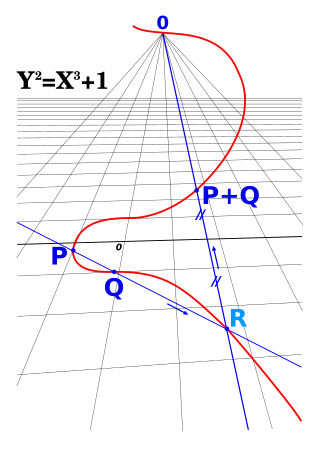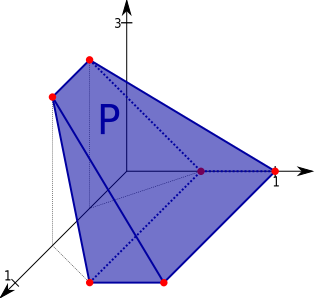In mathematics, an integral domain is a nonzero commutative ring in which the product of any two nonzero elements is nonzero. Integral domains are generalizations of the ring of integers and provide a natural setting for studying divisibility. In an integral domain, every nonzero element a has the cancellation property, that is, if a ≠ 0, an equality ab = ac implies b = c.
In abstract algebra, a Dedekind domain or Dedekind ring, named after Richard Dedekind, is an integral domain in which every nonzero proper ideal factors into a product of prime ideals. It can be shown that such a factorization is then necessarily unique up to the order of the factors. There are at least three other characterizations of Dedekind domains that are sometimes taken as the definition: see below.
In mathematics, an integral polytope has an associated Ehrhart polynomial that encodes the relationship between the volume of a polytope and the number of integer points the polytope contains. The theory of Ehrhart polynomials can be seen as a higher-dimensional generalization of Pick's theorem in the Euclidean plane.

In algebraic geometry, a projective variety over an algebraically closed field k is a subset of some projective n-space over k that is the zero-locus of some finite family of homogeneous polynomials of n + 1 variables with coefficients in k, that generate a prime ideal, the defining ideal of the variety. Equivalently, an algebraic variety is projective if it can be embedded as a Zariski closed subvariety of .

In geometry and group theory, a lattice in the real coordinate space is an infinite set of points in this space with the properties that coordinate-wise addition or subtraction of two points in the lattice produces another lattice point, that the lattice points are all separated by some minimum distance, and that every point in the space is within some maximum distance of a lattice point. Closure under addition and subtraction means that a lattice must be a subgroup of the additive group of the points in the space, and the requirements of minimum and maximum distance can be summarized by saying that a lattice is a Delone set. More abstractly, a lattice can be described as a free abelian group of dimension which spans the vector space . For any basis of , the subgroup of all linear combinations with integer coefficients of the basis vectors forms a lattice, and every lattice can be formed from a basis in this way. A lattice may be viewed as a regular tiling of a space by a primitive cell.
In mathematics, a duality translates concepts, theorems or mathematical structures into other concepts, theorems or structures in a one-to-one fashion, often by means of an involution operation: if the dual of A is B, then the dual of B is A. Such involutions sometimes have fixed points, so that the dual of A is A itself. For example, Desargues' theorem is self-dual in this sense under the standard duality in projective geometry.
In algebraic geometry, a toric variety or torus embedding is an algebraic variety containing an algebraic torus as an open dense subset, such that the action of the torus on itself extends to the whole variety. Some authors also require it to be normal. Toric varieties form an important and rich class of examples in algebraic geometry, which often provide a testing ground for theorems. The geometry of a toric variety is fully determined by the combinatorics of its associated fan, which often makes computations far more tractable. For a certain special, but still quite general class of toric varieties, this information is also encoded in a polytope, which creates a powerful connection of the subject with convex geometry. Familiar examples of toric varieties are affine space, projective spaces, products of projective spaces and bundles over projective space.
In mathematics, a vertex operator algebra (VOA) is an algebraic structure that plays an important role in two-dimensional conformal field theory and string theory. In addition to physical applications, vertex operator algebras have proven useful in purely mathematical contexts such as monstrous moonshine and the geometric Langlands correspondence.
In mathematics, the Grothendieck group, or group of differences, of a commutative monoid M is a certain abelian group. This abelian group is constructed from M in the most universal way, in the sense that any abelian group containing a homomorphic image of M will also contain a homomorphic image of the Grothendieck group of M. The Grothendieck group construction takes its name from a specific case in category theory, introduced by Alexander Grothendieck in his proof of the Grothendieck–Riemann–Roch theorem, which resulted in the development of K-theory. This specific case is the monoid of isomorphism classes of objects of an abelian category, with the direct sum as its operation.
In mathematics, the E8 lattice is a special lattice in R8. It can be characterized as the unique positive-definite, even, unimodular lattice of rank 8. The name derives from the fact that it is the root lattice of the E8 root system.

A convex polytope is a special case of a polytope, having the additional property that it is also a convex set contained in the -dimensional Euclidean space . Most texts use the term "polytope" for a bounded convex polytope, and the word "polyhedron" for the more general, possibly unbounded object. Others allow polytopes to be unbounded. The terms "bounded/unbounded convex polytope" will be used below whenever the boundedness is critical to the discussed issue. Yet other texts identify a convex polytope with its boundary.

In linear algebra, a cone—sometimes called a linear cone for distinguishing it from other sorts of cones—is a subset of a vector space that is closed under positive scalar multiplication; that is, C is a cone if implies for every positive scalar s. A cone need not be convex, or even look like a cone in Euclidean space.
In algebraic geometry, the normal cone of a subscheme of a scheme is a scheme analogous to the normal bundle or tubular neighborhood in differential geometry.
The Hilbert basis of a convex cone C is a minimal set of integer vectors such that every integer vector in C is a conical combination of the vectors in the Hilbert basis with integer coefficients.
In mathematics, the relative interior of a set is a refinement of the concept of the interior, which is often more useful when dealing with low-dimensional sets placed in higher-dimensional spaces.
In mathematics, a refinement monoid is a commutative monoid M such that for any elements a0, a1, b0, b1 of M such that a0+a1=b0+b1, there are elements c00, c01, c10, c11 of M such that a0=c00+c01, a1=c10+c11, b0=c00+c10, and b1=c01+c11.

The study of integer points in convex polyhedra is motivated by questions such as "how many nonnegative integer-valued solutions does a system of linear equations with nonnegative coefficients have" or "how many solutions does an integer linear program have". Counting integer points in polyhedra or other questions about them arise in representation theory, commutative algebra, algebraic geometry, statistics, and computer science.
This is a glossary of algebraic geometry.
In algebraic geometry, a derived scheme is a homotopy-theoretic generalization of a scheme in which classical commutative rings are replaced with derived versions such as cdgas, commutative simplicial rings, or commutative ring spectra.
In abstract algebra, a branch of mathematics, an affine monoid is a commutative monoid that is finitely generated, and is isomorphic to a submonoid of a free abelian group . Affine monoids are closely connected to convex polyhedra, and their associated algebras are of much use in the algebraic study of these geometric objects.




















